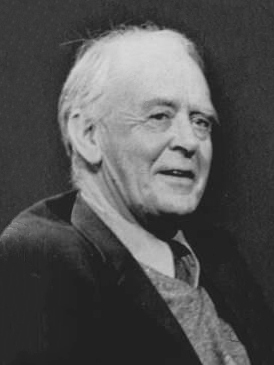
John R. Hicks
1904-1989

The British economist John Hicks is known for four contributions. The first is his introduction of the idea of the elasticity of substitution. While the concept is difficult to explain in a few words, Hicks used it to show, contrary to the marxist allegations, that labor-saving technical progress—the kind we generally have—does not necessarily reduce labor’s share of national income.
His second major contribution is his invention of what is called the IS-LM model, a graphical depiction of the argument John Maynard Keynes gave in his General Theory of Employment, Interest and Money (1936) about how an economy could be in equilibrium with less than full employment. Hicks published it in a journal article the year after Keynes’s book was published. It seems safe to say that most economists became familiar with Keynes’s argument by seeing Hicks’s graph.
Hicks’s third major contribution is his 1939 book Value and Capital, in which he showed that most of what economists then understood and believed about value theory (the theory about why goods have value) can be derived without having to assume that utility is measurable. His book was also one of the first works on general equilibrium theory, the theory about how all markets fit together and reach equilibrium.
Hicks’s fourth contribution is the idea of the compensation test. Before his test, economists were hesitant to say that one particular outcome was preferable to another because even a policy that benefited millions of people could hurt some people. Free trade in cars, for example, helps millions of American consumers at the expense of thousands of American workers and owners of stock in U.S. auto companies. How was an economist to judge whether the help to some outweighed the hurt to others? Hicks asked if those helped could compensate those hurt to the full extent of their hurt and still be better off. If the answer was yes, then the policy passed the “Hicks compensation test,” even if the compensation was never paid, and was judged to be good. In the auto example economists can show that the dollar gains to car buyers far outweigh the dollar losses to workers and stockholders, and therefore, by Hicks’s compensation test, free trade is good.
In 1972 John Hicks and kenneth arrow jointly received the Nobel Prize for economics “for their pioneering contributions to general economic equilibrium theory and welfare theory.” Educated at Balliol College, Oxford, John Hicks returned there as the Drummond Professor of Political Economy, a post he held until his retirement in 1965. In 1935 he married the economist Ursula Webb. He was knighted in 1964.
About the Author
David R. Henderson is the editor of The Concise Encyclopedia of Economics. He is also an emeritus professor of economics with the Naval Postgraduate School and a research fellow with the Hoover Institution at Stanford University. He earned his Ph.D. in economics at UCLA.
Selected Works
Related Entries
Related Links
Arnold Kling, Aggregate Demand, An Economics Topic Detail at Econlib
Adam Martin, Hayek, Mises, and the Methodology of the Social Sciences, a Liberty Classic at Econlib.
Pedro Schwartz, Continual Erosion and the “General Equilibrium,” at Econlib, May 2, 2016.
Don Boudreaux on Macroeconomics and Austrian Business Cycle Theory, an EconTalk podcast, April 13, 2009.
